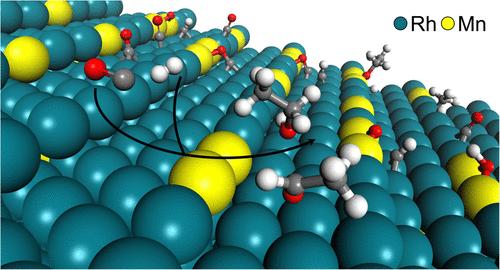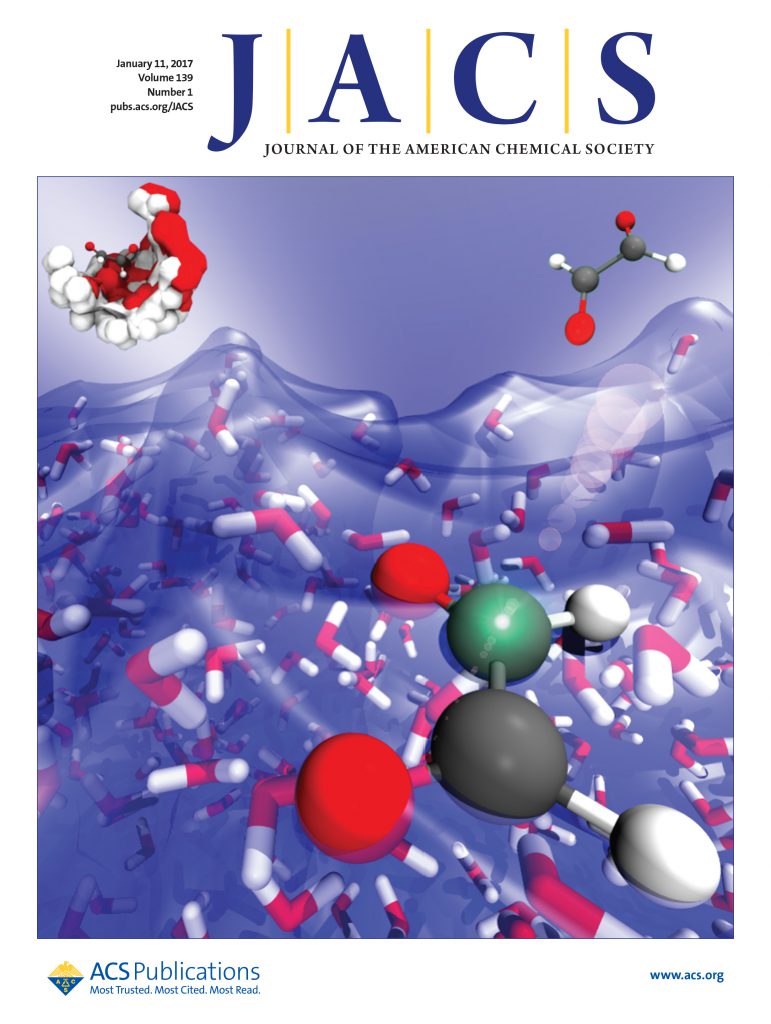锰-锰二元催化剂的原位表面锰-锰二聚位决定 CO 加氢活性和 C2 选择性
IF 15.6
1区 化学
Q1 CHEMISTRY, MULTIDISCIPLINARY
引用次数: 0
摘要
大规模生产乙醇一直是人类社会的梦想。尽管在过去几十年中进行了广泛的研究,但只有少数系统具有工业化的潜力:特别是锰促进的 Rh(MnRh)二元异相催化剂在将合成气(CO/H2)转化为乙醇的过程中,C2 含氧化合物的选择性可高达 60%。然而,二元体系的活性位点特征仍然不甚明了。在此,我们利用大规模机器学习全局优化技术,通过探索数百万种可能的结构,确定了 Rh 金属表面在反应条件下最稳定的锰相。我们证明,锰更喜欢 Rh 金属表面的次表层位点,一旦存在氧化性 O/OH 吸附物,锰就会出现在表面上,形成 MnRh 表面合金。我们基于机器学习的过渡态探索进一步帮助自动解析了整个反应网络,包括在不同 MnRh 表面位点上的 74 个基本反应,并揭示了位于单原子阶梯边缘的 Mn-Mn 二聚位点是 C2 氧酸根形成的真正活性位点。我们的结果证明了锰锰二聚位点在允许 C-O 键裂解和促进 O 端 C2 中间产物氢化方面的关键催化作用,并排除了 Rh 金属本身作为 CO 氢化为 C2 氧代物的活性位点的可能性。本文章由计算机程序翻译,如有差异,请以英文原文为准。

In Situ Surfaced Mn–Mn Dimeric Sites Dictate CO Hydrogenation Activity and C2 Selectivity over MnRh Binary Catalysts
Massive ethanol production has long been a dream of human society. Despite extensive research in past decades, only a few systems have the potential of industrialization: specifically, Mn-promoted Rh (MnRh) binary heterogeneous catalysts were shown to achieve up to 60% C2 oxygenates selectivity in converting syngas (CO/H2) to ethanol. However, the active site of the binary system has remained poorly characterized. Here, large-scale machine-learning global optimization is utilized to identify the most stable Mn phases on Rh metal surfaces under reaction conditions by exploring millions of likely structures. We demonstrate that Mn prefers the subsurface sites of Rh metal surfaces and is able to emerge onto the surface forming MnRh surface alloy once the oxidative O/OH adsorbates are present. Our machine-learning-based transition state exploration further helps to resolve automatedly the whole reaction network, including 74 elementary reactions on various MnRh surface sites, and reveals that the Mn–Mn dimeric site at the monatomic step edge is the true active site for C2 oxygenate formation. The turnover frequency of the C2 product on the Mn–Mn dimeric site at MnRh steps is at least 107 higher than that on pure Rh steps from our microkinetic simulations, with the selectivity to the C2 product being 52% at 523 K. Our results demonstrate the key catalytic role of Mn–Mn dimeric sites in allowing C–O bond cleavage and facilitating the hydrogenation of O-terminating C2 intermediates, and rule out Rh metal by itself as the active site for CO hydrogenation to C2 oxygenates.
求助全文
通过发布文献求助,成功后即可免费获取论文全文。
去求助
来源期刊
CiteScore
24.40
自引率
6.00%
发文量
2398
审稿时长
1.6 months
期刊介绍:
The flagship journal of the American Chemical Society, known as the Journal of the American Chemical Society (JACS), has been a prestigious publication since its establishment in 1879. It holds a preeminent position in the field of chemistry and related interdisciplinary sciences. JACS is committed to disseminating cutting-edge research papers, covering a wide range of topics, and encompasses approximately 19,000 pages of Articles, Communications, and Perspectives annually. With a weekly publication frequency, JACS plays a vital role in advancing the field of chemistry by providing essential research.

 求助内容:
求助内容: 应助结果提醒方式:
应助结果提醒方式:


